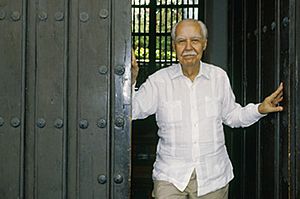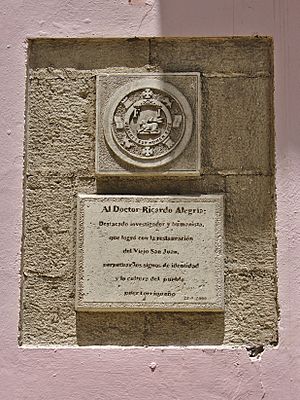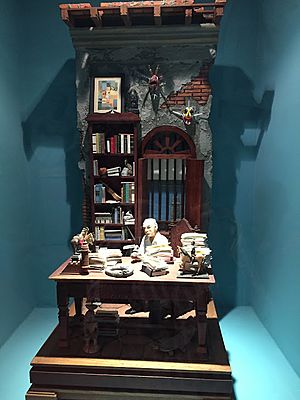Ricardo Alegría facts for kids
Quick facts for kids
Ricardo Alegría
|
|
|---|---|
 |
|
| Born | April 14, 1921 |
| Died | July 7, 2011 (aged 90) |
| Nationality | Puerto Rican |
| Occupation | cultural anthropologist and archeologist |
| Spouse(s) | Carmen Pons |
| Children | 1 |
Ricardo E. Alegría Gallardo (born April 14, 1921 – died July 7, 2011) was a famous Puerto Rican expert. He was a cultural anthropologist and archaeologist. People often called him the "father of modern Puerto Rican archaeology" because of his important work.
Contents
Ricardo Alegría's Early Life and Education
Ricardo Alegría was born in San Juan, Puerto Rico. He went to school there for his early education. His dad, José S. Alegría, was a founding member of a political group called the Puerto Rican Nationalist Party. Ricardo's father taught him to love and be proud of Puerto Rico, its history, and its culture.
In 1941, while at the University of Puerto Rico, Ricardo helped start a new student group. He earned his first degree in archaeology from the University of Puerto Rico in 1942. He then continued his studies in the University of Chicago, getting his master's degree in Anthropology and History in 1947. Later, in 1954, Alegría earned his highest degree, a Ph.D., in Anthropology from Harvard University.
Ricardo Alegría's Amazing Work and Legacy
Ricardo Alegría became the very first director of the Institute of Puerto Rican Culture. This was a big job given to him by Luis Muñoz Marín, who was Puerto Rico's first elected governor.
Protecting Puerto Rico's History
Alegría helped create many important places and programs:
- He started the "Archaeological Center of Investigation" at the University of Puerto Rico. This center helps study old things found in the ground.
- He created the "Center of Popular Arts of the Puerto Rican Cultural Institute." This place helps keep traditional Puerto Rican arts alive.
- He also started a program to publish books about Puerto Rican culture and history.
- He even designed the logo for the Institute of Neurobiology in Puerto Rico.
Saving Old San Juan and Other Sites
Ricardo Alegría was key in making Old San Juan beautiful again. He worked with the mayor of San Juan, Felisa Rincón de Gautier, to fix up and restore many historic buildings. Because of his hard work, Old San Juan was named a "Historical World Treasure." This means it's a very important place for everyone in the world to protect.
He also led efforts to restore old ruins like the Caparra Archaeological Site and Fortín de San Gerónimo. These are important historical places that tell us about Puerto Rico's past.
Creating New Centers for Learning
In 1976, Alegría opened the Center of Advanced Studies of Puerto Rico and the Caribbean. This center helps people learn more about the region. In 1992, he also started the Museum of the Americas. This museum shows the history and art of different cultures in the Americas.
Understanding Ancient Cultures
Alegría is seen as a pioneer in studying the Taíno culture. The Taíno were the native people of Puerto Rico before Europeans arrived. He also studied the African heritage in Puerto Rico. His research helped historians understand how the Taínos lived and what happened to them when the Spanish came. Alegría believed that about one-third of all Puerto Ricans have Taíno blood. Recent DNA studies have shown that he was right!
Later Life and Passing
Ricardo Alegría lived in Old San Juan for many years. He passed away on July 7, 2011, after being in the hospital.
Awards and Special Recognitions

Ricardo Alegría received many important awards for his work:
- In 1993, President Bill Clinton gave him the "Charles Frankel Prize." This award recognized his contributions to archaeology.
- In 1996, he received the "James Smithson Bicentennial Medal."
- In 2001, he was given "The Haydee Santamaria Medal" in Havana, Cuba.
- In 2002, Puerto Rican Governor Sila Calderón presented him with the "Luis Muñoz Marín Medal" for his lifetime achievements.
- A famous Puerto Rican artist, Lorenzo Homar, even made a special poster to honor him.
He also received honors from groups in Peru, Venezuela, Mexico, and the Dominican Republic. The city of Havana, Cuba, recognized his influence on their own city restoration project. They honored him with a plaque, which was the only monument in the city for a living Puerto Rican at the time.
A Puerto Rican music group called Los Niños Estelares even wrote a song about him in 2010. The song, called "Alegría, Doctor Alegría," talked about his accomplishments. They even joked that he was like Indiana Jones because of his amazing work! In the song, they called him "the last Puerto Rican hero."
Books by Ricardo Alegría
Ricardo Alegría wrote or helped write many books about history and culture. Here are some of them:
- "Ball Courts and Ceremonial Plazas in the West Indies" (1983)
- "The three wishes; a collection of Puerto Rican folktales" (1969) (with Lorenzo Homar)
- "History of the Indians of Puerto Rico" (1983)
- "El Instituto de Cultura Puertorriqueña, 1955–1973 : 18 años contribuyendo a fortalecer nuestra conciencia nacional" (1978)
- "Taino: Pre-Columbian Art & Culture from the Caribbean" (with Fatima Bercht and Jose J. Arrom) (1998)
- "Las primeras representaciones gráficas del indio americano, 1493–1523" (1978)
- "Descubrimiento, conquista y colonización de Puerto Rico, 1493–1599" (with Mela Pons Alegría) (1984)
- "Historia y Cultura de Puerto Rico: Desde La Epoca Pre-Colombina Hasta Nuestros Dias"
- "Excavations at Maria de La Cruz Cave & Hacienda Grande Village Site, Loiza, Puerto Rico" (with Irving Rouse) (1999)
- "La vida de Jesucristo según el santero puertorriqueño Florencio Cabán" (1983)
- "San Juan de Puerto Rico" (with Manuel Méndez Guerrero and María de los Angeles Castro Arroyo) (1989)
- "Cafe" (1967)
- "Programa De Parques Y Museos Del Instituto De Cultura Puertorriquena" (1973)
- "La Fiesta De Santiago Apostol En Loiza Aldea" (1954)
- "El Fuerte De San Jerónimo Del Boquerón" (1969)
- "El Ahijado De La Muerte"
See also
 In Spanish: Ricardo Alegría para niños
In Spanish: Ricardo Alegría para niños
- List of Puerto Ricans
- Puerto Rican scientists and inventors


